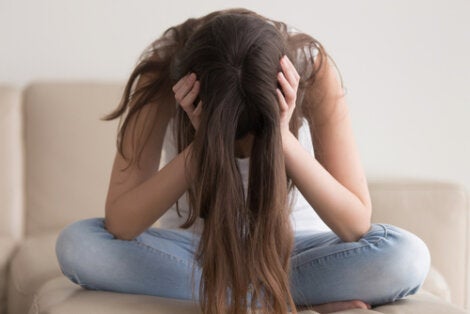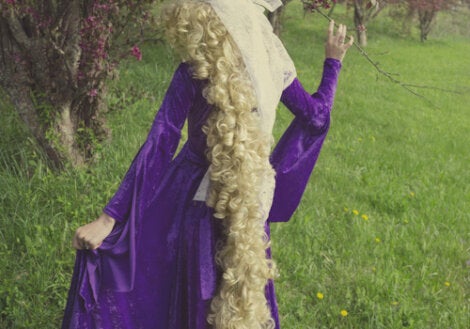Rapunzel Syndrome: Symptoms, Causes, and Treatment

Rapunzel syndrome is a very rare disorder. Individuals with Rapunzel syndrome have masses of hair in their stomach and intestines from voluntarily and compulsively eating their own hair (trichophagia).
This disorder is associated with trichotillomania and causes serious gastrointestinal complications. In today’s article, we’ll learn about trichotillomania and trichophagia, their symptoms, and the most effective treatments for these conditions.
Rapunzel syndrome primarily affects young women, but experts still aren’t completely clear on its causes. Doctors believe it’s related to low self-esteem, anxiety, and depression, as well as trichotillomania, which we already mentioned, and other mental disorders.

Symptoms of Rapunzel syndrome
The common name for a trichobezoar is a hairball. They form in the stomach or the intestines due to the ingestion of hair. Tricophagia, however, doesn’t always cause trichobezoars.
The time between when a person starts to ingest hair to when they start to have symptoms can vary. Some of the symptoms that point to a potential trichobezoar are:
- Weight loss.
- Signs that there’s something obstructing the stomach or the gut.
- Nausea, vomiting, always feeling really full, and inability to eat.
- Diarrhea.
- Halitosis.
- Iron-deficiency anemia.
- Bloody stools.
- Alopecia areata associated with trichotillomania.
This syndrome is difficult to diagnose because the patients tend to deny that they eat hair. The presence of one of the above symptoms can also be an indicator of trichophagia.
Not only that but the presence of alopecia can also indicate that the person has trichotillomania, which is the compulsive urge to pull out your own hair. People with trichotillomania also sometimes ingest their hair after they pull it out. This information can help medical professionals get a more accurate diagnosis.
Stool analysis, echography, MRIs, and gastroscopy help doctors arrive at a definitive diagnosis. Gastroscopy is the best technique for confirming the presence of trichobezoars.
Trichotillomania
Trichotillomania is also known as a hair pulling disorder or compulsive hair pulling. Individuals with this condition might pull hair from anywhere on their body, though the most common areas are the scalp, the eyebrows, and the eyelashes.
The hair pulling can be associated with different rituals, such as deliberately choosing which kind of hair to pull, touching it and feeling it, putting it in the mouth, etc.
Some people experience strange and uncomfortable sensations before pulling their hair out that improve after the fact. They don’t find pulling their hair out painful, though it often results in very visible hair loss, like “tonsure trichotillomania”.
This disorder most often affects women and can occur at any age. Its association with trichophagia is also more frequent in women. It’s a chronic and fluctuating disorder, though it can improve with the proper treatment.
Rapunzel syndrome
The first step to correcting the disorder is sometimes treating the trichotillomania. If you limit the hair pulling, the individual might also ingest less hair.
The treatment that experts recommend is the habit-reversal technique from Azrin and Nunn. The primary components of this technique are:
- Awareness. This involves coming up with a description of the problem (hair pulling), its history, and the results to foster an awareness of the problem in the patient.
- Competing response. During this phase of the treatment, the therapist helps the individual train and execute behavior that’s incompatible with the problematic behavior.
- Motivation. Next, the therapist helps motivate the patient to do what they’ve learned. They also go over all of the inconveniences that the problem creates, seek out social support, and talk publicly about their achievements.
- Generalization. Practice the entire process in different areas of the subject’s life.
Another strategy is exposure and response prevention. This involves exposing the patient to the unpleasant feelings that precede the hair pulling and block the execution of their response.
The goal is for the individual to get used to the sensation without needing to carry out the compulsive response.
Treatment for Rapunzel syndrome involves dissolving the masses, through a chemical or enzymatic process. You can also remove the trichobezoar using endoscopy or surgery, along with medical treatment of the potentially serious related complications.

Interesting facts about Rapunzel syndrome
Vaughan ED and his collaborators were the first to describe this condition in 1968. However, in the 12th century BC, some people were ingesting trichobezoar from animals because they believed that they had medicinal properties.
As we mentioned above, this disorder is very rare. Only about 100 cases have been recorded in the entire world. The name of the syndrome comes from Brother’s Grimm fairytale. You’re probably familiar with the story of Rapunzel, who was trapped in a tower and had to throw her long hair down the tower so the prince could climb it and rescue her.
In conclusion, trichobezoar might look a lot like Rapunzel’s locks since they’re usually in the shape of a tail or braid. It doesn’t matter what color the hair is before the patient ingests it. The resulting bezoar is always black, and can even contain bits of undigested food. The masses of hair can vary in size, shape, and weight (up to six pounds).
Rapunzel syndrome is a very rare disorder. Individuals with Rapunzel syndrome have masses of hair in their stomach and intestines from voluntarily and compulsively eating their own hair (trichophagia).
This disorder is associated with trichotillomania and causes serious gastrointestinal complications. In today’s article, we’ll learn about trichotillomania and trichophagia, their symptoms, and the most effective treatments for these conditions.
Rapunzel syndrome primarily affects young women, but experts still aren’t completely clear on its causes. Doctors believe it’s related to low self-esteem, anxiety, and depression, as well as trichotillomania, which we already mentioned, and other mental disorders.

Symptoms of Rapunzel syndrome
The common name for a trichobezoar is a hairball. They form in the stomach or the intestines due to the ingestion of hair. Tricophagia, however, doesn’t always cause trichobezoars.
The time between when a person starts to ingest hair to when they start to have symptoms can vary. Some of the symptoms that point to a potential trichobezoar are:
- Weight loss.
- Signs that there’s something obstructing the stomach or the gut.
- Nausea, vomiting, always feeling really full, and inability to eat.
- Diarrhea.
- Halitosis.
- Iron-deficiency anemia.
- Bloody stools.
- Alopecia areata associated with trichotillomania.
This syndrome is difficult to diagnose because the patients tend to deny that they eat hair. The presence of one of the above symptoms can also be an indicator of trichophagia.
Not only that but the presence of alopecia can also indicate that the person has trichotillomania, which is the compulsive urge to pull out your own hair. People with trichotillomania also sometimes ingest their hair after they pull it out. This information can help medical professionals get a more accurate diagnosis.
Stool analysis, echography, MRIs, and gastroscopy help doctors arrive at a definitive diagnosis. Gastroscopy is the best technique for confirming the presence of trichobezoars.
Trichotillomania
Trichotillomania is also known as a hair pulling disorder or compulsive hair pulling. Individuals with this condition might pull hair from anywhere on their body, though the most common areas are the scalp, the eyebrows, and the eyelashes.
The hair pulling can be associated with different rituals, such as deliberately choosing which kind of hair to pull, touching it and feeling it, putting it in the mouth, etc.
Some people experience strange and uncomfortable sensations before pulling their hair out that improve after the fact. They don’t find pulling their hair out painful, though it often results in very visible hair loss, like “tonsure trichotillomania”.
This disorder most often affects women and can occur at any age. Its association with trichophagia is also more frequent in women. It’s a chronic and fluctuating disorder, though it can improve with the proper treatment.
Rapunzel syndrome
The first step to correcting the disorder is sometimes treating the trichotillomania. If you limit the hair pulling, the individual might also ingest less hair.
The treatment that experts recommend is the habit-reversal technique from Azrin and Nunn. The primary components of this technique are:
- Awareness. This involves coming up with a description of the problem (hair pulling), its history, and the results to foster an awareness of the problem in the patient.
- Competing response. During this phase of the treatment, the therapist helps the individual train and execute behavior that’s incompatible with the problematic behavior.
- Motivation. Next, the therapist helps motivate the patient to do what they’ve learned. They also go over all of the inconveniences that the problem creates, seek out social support, and talk publicly about their achievements.
- Generalization. Practice the entire process in different areas of the subject’s life.
Another strategy is exposure and response prevention. This involves exposing the patient to the unpleasant feelings that precede the hair pulling and block the execution of their response.
The goal is for the individual to get used to the sensation without needing to carry out the compulsive response.
Treatment for Rapunzel syndrome involves dissolving the masses, through a chemical or enzymatic process. You can also remove the trichobezoar using endoscopy or surgery, along with medical treatment of the potentially serious related complications.

Interesting facts about Rapunzel syndrome
Vaughan ED and his collaborators were the first to describe this condition in 1968. However, in the 12th century BC, some people were ingesting trichobezoar from animals because they believed that they had medicinal properties.
As we mentioned above, this disorder is very rare. Only about 100 cases have been recorded in the entire world. The name of the syndrome comes from Brother’s Grimm fairytale. You’re probably familiar with the story of Rapunzel, who was trapped in a tower and had to throw her long hair down the tower so the prince could climb it and rescue her.
In conclusion, trichobezoar might look a lot like Rapunzel’s locks since they’re usually in the shape of a tail or braid. It doesn’t matter what color the hair is before the patient ingests it. The resulting bezoar is always black, and can even contain bits of undigested food. The masses of hair can vary in size, shape, and weight (up to six pounds).
This text is provided for informational purposes only and does not replace consultation with a professional. If in doubt, consult your specialist.







